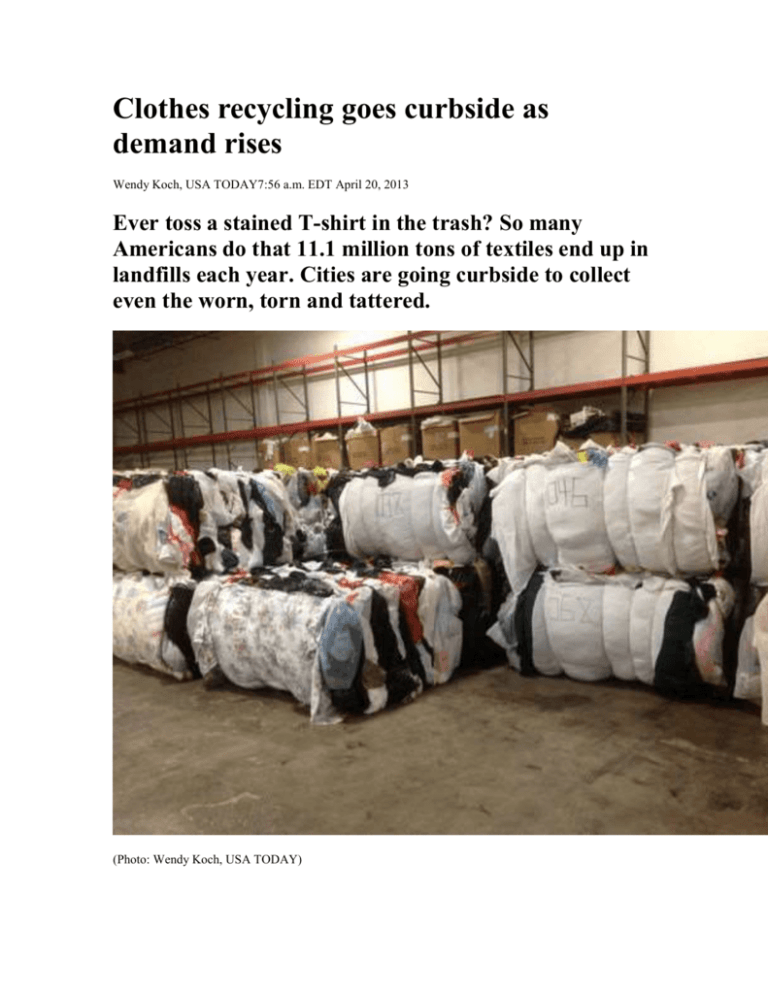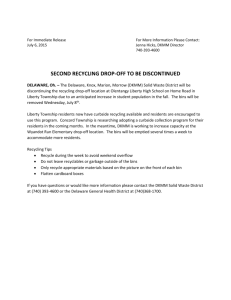Clothes recycling is going curbside in more US towns
advertisement

Clothes recycling goes curbside as demand rises Wendy Koch, USA TODAY7:56 a.m. EDT April 20, 2013 Ever toss a stained T-shirt in the trash? So many Americans do that 11.1 million tons of textiles end up in landfills each year. Cities are going curbside to collect even the worn, torn and tattered. (Photo: Wendy Koch, USA TODAY) Story Highlights Many recyclers will accept torn, worn or stained clothes Nearly half of donations are sold for reuse, mostly overseas Businesses are placing collection bins in parking lots and gas stations Clothes recycling is going curbside in more U.S. towns as global prices rise for the used apparel, shoes and linens that Americans often toss in the trash. Since September, more than a dozen local governments -- in Arizona, Massachusetts, New Jersey, Pennsylvania and Washington state -- have begun curbside pickup of textiles, often in special bags next to bins containing paper and cans. New York City has put clothing collection bins in nearly 250 apartment buildings in the last two years. Businesses, too, are placing collection bins in parking lots and gas stations. In the last year, The North Face, H&M and other retailers have begun using in-store bins to offer customers store vouchers for donating clothes -- whatever the brand, and sometimes, whatever the condition. As the U.S. celebrates Earth Day Monday, the nation's robust recycling industry is increasingly targeting clothes -- even those that are stained, ripped, mismatched or out-of-fashion. Companies and non-profit groups are partnering with cities eager to reduce landfill costs. They pick up the clothes, sell or reprocess them into wiping rags and other goods, and give the cities or local charities a cut of the pie -- often pennies per pound. ""It's a trend more cities are considering." says Tom Watson, a recycling official in Washington state's King County, where the Seattle suburb of Issaquah has teamed up with waste collector CleanScapes for curbside pickups. As a result, he says non-profits such as Goodwill Industries International and Salvation Army face more competition for donations. Queen Creek, Ariz., launched a curbside pilot project in September that collected 27,000 pounds of material in four months and earned nearly $3,000 for both the city and its Boys and Girls Club. It partnered with United Fibers, a company that turns textiles into insulation "This is stuff I wouldn't want to give away," says Ramona Simpson, the town's environmental programs supervisor, referring to items that are no longer wearable and wouldn't sell at Goodwill or other charity stores. She says the town, after developing a stronger bag for collecting clothes, will soon relaunch the program. Salvation Army began partnering this year with Massachusetts' Brockton and Worcester to pick up clothes curbside. Community Recycling, a for-profit that sells clothes for reuse, started pickups in October in Pennsylvania's Newtown and a dozen neighboring communities and will do the same next month in Westville, N.J. "Anything that is clean and dry can be reused or recycled," says Jackie King, executive director of Secondary Materials and Recycled Textiles Association, an industry group. She says nearly half of donated clothes are sold for reuse, mostly overseas where demand and prices have risen. Goodwill's Michael Meyer says per-pound international prices vary but have risen from a low of about three cents to 20 cents. He says his non-profit, which requests "new and gently used" items to fund job training programs, sells only a small share of donations abroad, because it sells the "vast majority" at its stores, outlets or auctions. King says the average American throws away 70 pounds of clothing, linens and other textiles each year. Textiles account for 5% of municipal waste, because only about 15% of them are recycled -- compared with 72% of newspapers and 50% of soda cans, according to the U.S. Environmental Protection Agency. "There's a lot of room for improvement," says Jennifer Berry of Earth911.com, a website that lists, by ZIP code, places where myriad items can be recycled. "Clothes clog our landfills. They don't decompose", says Kelly Jamieson of Planet Aid, a non-profit with bright yellow collection bins in many metro areas. "We're very privileged people. We throw away things many other people never would." Her group placed bins on college campuses nationwide last week as part of the "OneShirt Challenge" for Earth Day, aimed at educating students on the need to recycle even the rattiest T-shirts. "My friends just let things pile up in their rooms, which is a pretty big waste," says Jan Nguyen, a University of Maryland student who's donating old athletic shoes. She says she rarely throws anything away and uses socks that have lost their mate as chalkboard erasers. With super-cheap manufacturing. clothes are falling apart and being thrown away at a faster rate, says Heather Rogers, author of Green Gone Wrong: How Our Economy is Undermining the Environmental Revolution. "There's been a transformation of clothing into a disposable item." Watson, the Washington recycling official, says consumers should consider buying fewer but higherquality items that will last longer, noting the average American buys at least twice as many pieces of clothing as 20 years ago. He suggests they avoid impulsive purchases, take good care of their clothes and, when possible, buy used items at thrift stores.






